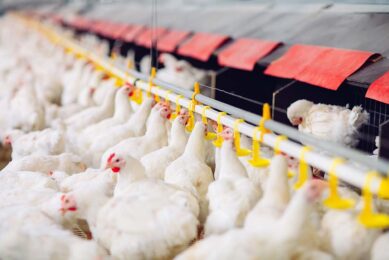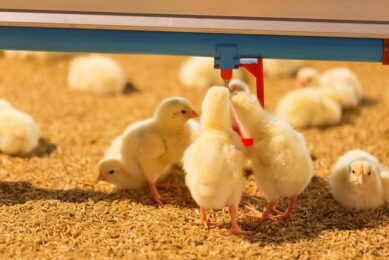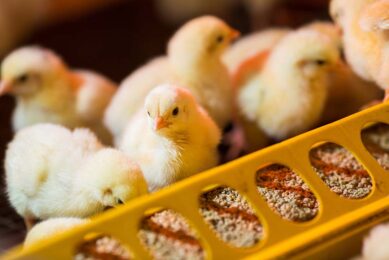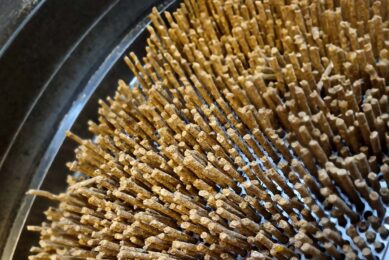Antibiotic reduction through nutrition
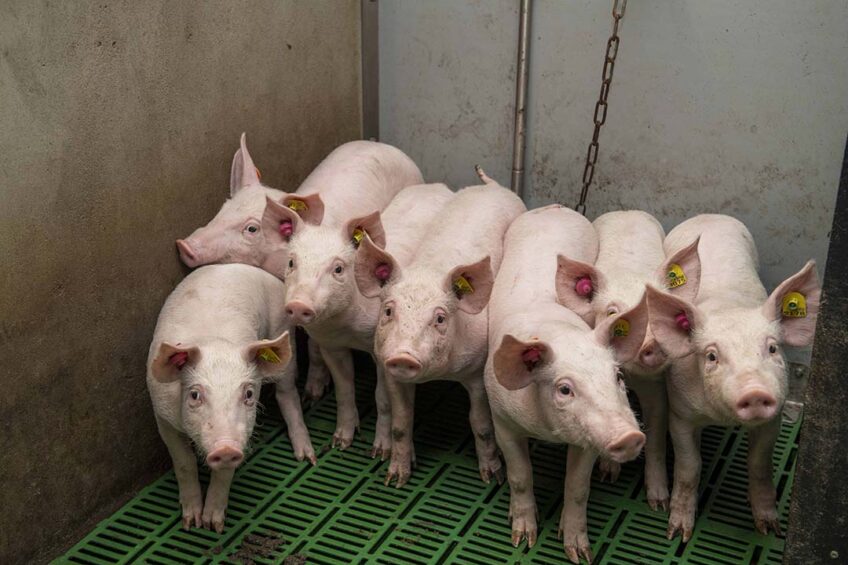
Reducing the use of antibiotics is a continuous hot topic in pig and poultry production. This article provides recent insights gained in EU-project AVANT about the perspectives of consumers, vets and pig producers regarding antimicrobial usage and potential alternatives. With feeding strategies being suggested by the survey as one of the highly accepted alternatives for antimicrobials, this article will focus on some nutritional solutions to replace antibiotics in pigs and poultry.
ANTIBIOTIC REDUCTION SPECIAL 2023 – read all articles
Pathogenic bacteria in pigs and poultry that are resistant against certain antibiotics, can be passed to humans via the food chain. In humans, these bacteria can multiply or pass their resistance properties to other bacteria that can cause disease in humans. In case of multi-resistance of human pathogens to multiple antibiotics, which means that none of the available antibiotics works against the pathogen, this can have fatal consequences. AVANT is a running EU-project aiming at developing alternatives for antimicrobials for bacterial infections in pigs, especially post-weaning diarrhoea, as the major indication for antimicrobial use in livestock in Europe. Schothorst Feed Research (SFR) is one of the participants of AVANT and work package leader on the nutritional strategies tested in the project. As part of the project, more than 2,300 veterinarians, pig farmers and consumers from 5 European countries were interviewed about, amongst other questions, their opinion about antibiotic resistance. More than 70% of the participants (vets, producers and consumers) agreed that antibiotic resistance is a public health problem and that it is needed to reduce antibiotics in animals. Additionally, more than 65% of the consumers answered that they would be willing to pay 10% more for meat produced with less antibiotics.
Figure 1 – The use of antibiotics in livestock in the Netherlands from 1999 to 2022.
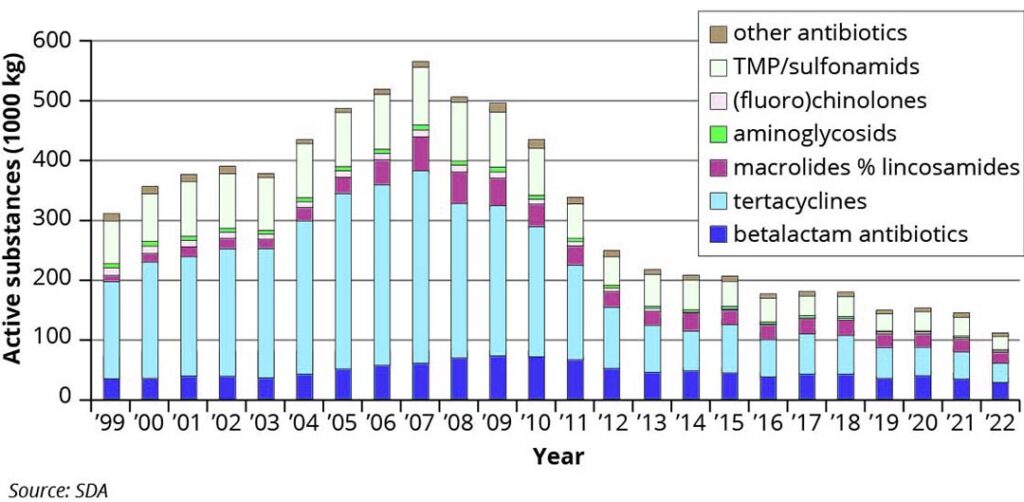
Huge reduction in antibiotic use
In the EU, already from 2006, Anti-Microbial Growth Promotors (AMGP’s) have been forbidden in diets of pigs and poultry. Since then, a significant reduction in the use of antibiotics has been realised. Figure 1 shows the huge decrease in the use of antibiotics in livestock in the Netherlands. More recently, other developments in the EU have increased the attention to antibiotic use in pigs and poultry: Since June 2022, the use of therapeutic dosages of zinc oxide (ZnO) in pigs have been forbidden in the EU. This has led to more cases of post-weaning diarrhoea and oedema disease in piglets, forcing farmers to look for alternative strategies like antibiotic use or measures in management, biosecurity and nutrition. Also, the use of colistin in pigs and poultry is under pressure, since its equivalent in human medicine is often a last resort antibiotic in case of multi-resistant pathogenic bacteria. In the Netherlands, several measures to reduce the use of colistin in piglets and layer hens have led to a reduction in its use, and additional measurements to reduce it further currently take place.
Figure 2 – Results from 5 EU countries questioning veterinarians and pig producers about the implementation, safety and effectiveness of four different intervention strategies.
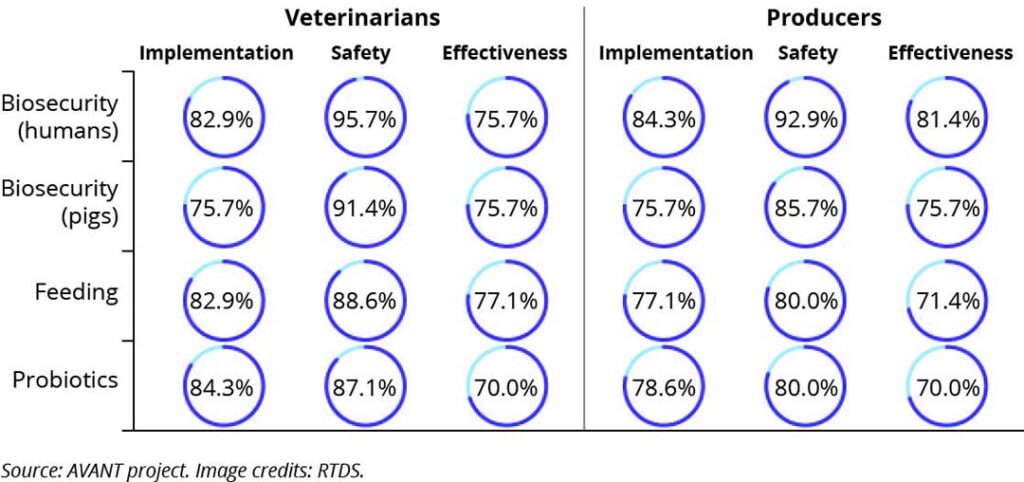
Nutritional alternatives for antibiotics
From the AVANT interview it became clear that by far the best ways to reduce antibiotic use in pigs are to apply a strict biosecurity, to have the best management practices and to have optimal housing and climate conditions for the animals. However, also with nutritional means it is possible to reduce the use of antibiotics since with nutrition, animal resilience can be enhanced and symptoms can be suppressed. In both pigs and broilers, the main nutritional levers that can be pulled are: protein, fibre, buffering capacity, fat, particle size and targeted additives. Within the AVANT project, stakeholders were questioned regarding their impression about the potential of proposed alternatives for antibiotics to prevent post-weaning diarrhoea in piglets. In comparison to the biosecurity procedures as golden standard, feeding strategies and probiotics were mentioned as the most accepted alternative solutions, followed by immunostimulants. Moreover, their implementation, safety and effectiveness were scored high by both veterinarians as well as farmers (Figure 2). Currently the interventions that are mostly used by European pig producers to reduce antibiotics are vaccination, biosecurity measures, management strategies, feed additives, a closed herd system and pre-weaning feeding strategies (Figure 3).
Figure 3 – Results from five EU countries questioned about the interventions that are currently being used by pig producers / recommended by pig vets to reduce antibiotic resistance.
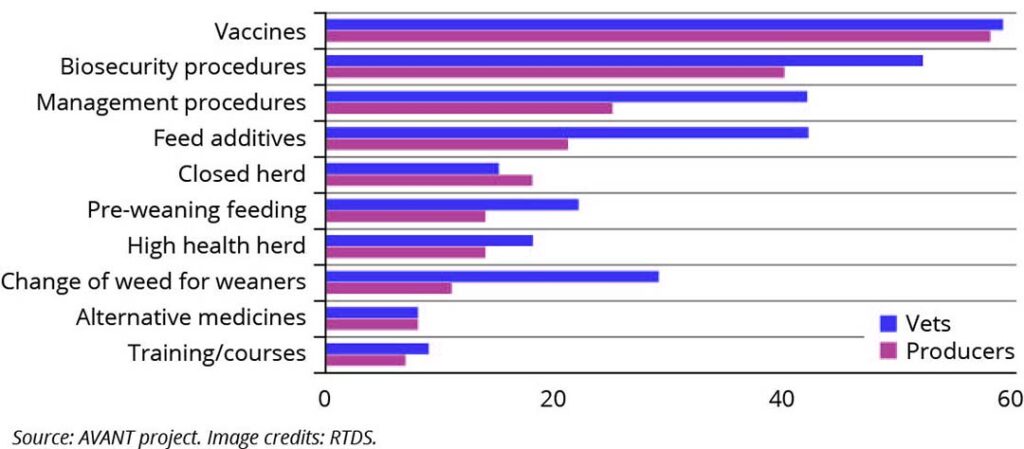
Reduction of crude protein
One of the most successful ways to reduce diarrhoea in piglets and to improve gut health in broilers is to reduce crude protein in the feed. By reducing crude protein, less undigested protein will enter the large intestine. Since undigested protein is a substrate for pathogenic bacteria, reduction of crude protein will result in less intestinal disorders. A meta-analysis conducted by Luise et al. in 2019 summarised 26 trials done in piglets with reduced protein in the diet. By far most of the trials showed less diarrhoea when reducing the protein content of the feed. Moreover, the growth performance and FCR did not get worse while reducing the protein level. In the Netherlands, also in broilers it has been demonstrated that protein reduction results in a better intestinal health. For that reason, nowadays a relative reduction of about 10% in CP content is being pursued in broiler diets in the Netherlands: from 21% to 19% (day 0-10), from 20% to 18% (day 10-20), from 19% to 17% (day 20-30), and from 18.5% to 16.5% (day 30-end).
Fermentable and inert fibres
Also, the fibre fraction of the feed plays an important role in the risk of diarrhoea. SFR performed many experiments with fibres and identified on basis of this research 2 types of fibre: Inert fibre and fermentable fibre. Inert fibre is not digested, nor is it being fermented, and it leaves the body unchanged. A main effect of inert fibres is that it leads to a more gradual emptying of the stomach, leading to a better digestion and hence less diarrhoea. On the other hand, fermentable fibres can be a substrate for pathogenic bacteria, and so their level in the feed should be limited. SFR conducted an experiment in weaned piglets with 3 treatments: a luxurious weaner diet (positive control), a standard weaner diet (negative control) and a standard weaner diet diluted with inert fibres, achieved by adding 10% oat hulls and 5% wheat straw to the feed. It was found that the diet dilution with inert fibre sources improved the feed intake, daily gain and reduced diarrhoea prevalence of the piglets compared to the luxury diet and the standard diet. Not only the fibre content and the type of fibres play a role, but also the particle size in the feed does. Fibres need to have a certain coarseness, to be able to exert a positive effect on gut health. When they are too finely ground, this effect will be lost.
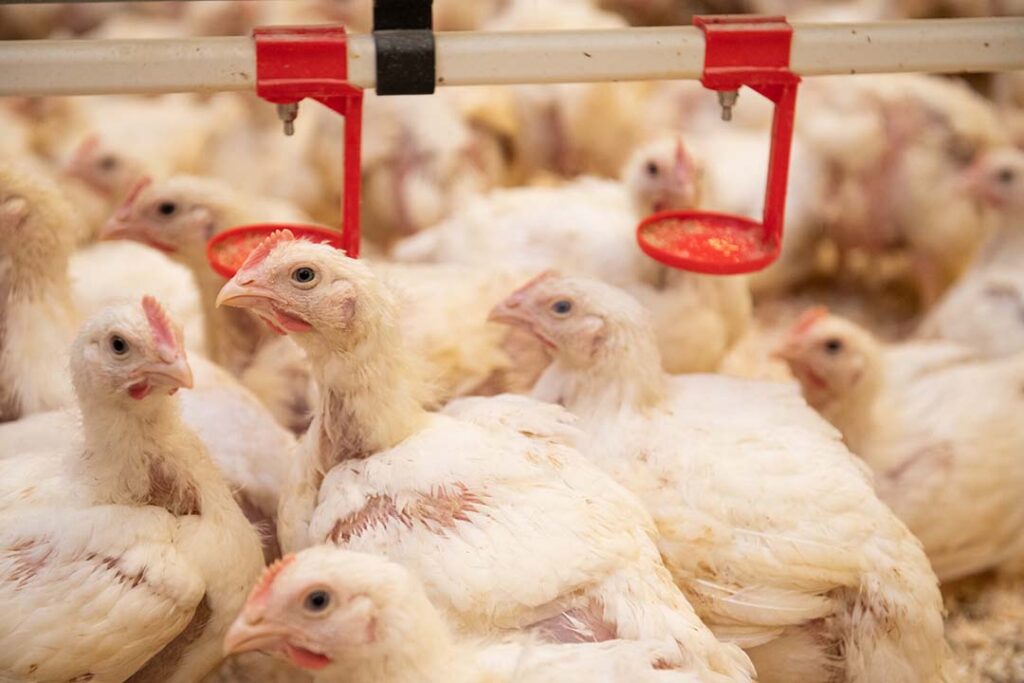
Targeted additives
Certain additives can also serve as an alternative for antibiotics. Vanrolleghem performed a meta-analysis in 2019 of 50 experiments with feed additives in piglets. The result showed that anti-microbial peptides, chitosan, lysozyme, medium chain fatty acids and phytogenics gave a statistically significant improvement in growth performance and feed conversion ratio when compared to a feed without antibiotics. However, when compared to a feed with antibiotics, these effects could not be demonstrated significantly. In 2023, Kansas State University published a meta-analysis of trials with feed additives in growing-finishing pigs. The conclusions were that for feed efficiency (gain to feed), the percentage improvements were for acidifiers 3.1%, for betaine 2.7%, for Conjugated Linoleic Acid 3.5%, for multi-enzymes 3.3% for direct fed microbials 3.3%, for L-carnitine 2.5% and for yeasts 2.7%. In Europe, short and medium chain organic acids are by far the most used additives to replace antibiotics. Those organic acids suppress pathogenic bacteria and improve protein digestion. However, they can only exert these effects in an optimal way when the buffering capacity of the feed is low. At a high buffering capacity of the feed, the effects of organic acids will be limited. With the right choice of raw materials, a low buffering capacity of the feed can be achieved.
Reducing antibiotic use
Reduction of the use of antibiotics is a continuous hot topic in pig and poultry production. There is a demand to reduce the use of antibiotics in animal production, which is perceived as a driver to the spread of antibiotic resistance in animals, and possible zoonotic transmission to humans. Alternatives to antibiotics could offer a pathway of change. In both pigs and broilers, the main nutritional levers that can be pulled to reduce antibiotics are protein, fibre, particle size, buffering capacity and targeted additives.



